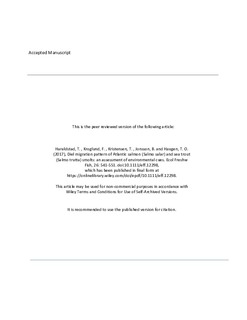Diel migration pattern of Atlantic salmon (Salmo salar) and sea trout (Salmo trutta) smolts: an assessment of environmental cues
Journal article, Peer reviewed
Accepted version
Permanent lenke
http://hdl.handle.net/11250/2564302Utgivelsesdato
2017Metadata
Vis full innførselSamlinger
- Publikasjoner fra Cristin - NIVA [2160]
- Scientific publications [1172]
Sammendrag
The timing of smolt migration is a key phenological trait with profound implications for individual survival during both river descent and the subsequent sea sojourn of anadromous fish. We studied relationships between the time of smolt migration, water temperature and light intensity for Atlantic salmon (Salmo salar) and sea trout (Salmo trutta). During 2006–2012, migrating smolts descending the southern Norway River Storelva were caught in a rotary screw trap located at the river mouth. The date of 50% cumulative smolt descent correlated significantly with the date when the river temperature exceeded 8°C for both Atlantic salmon and sea trout smolts. In 2010, smolts of both species were passive integrated transponder (PIT)-tagged, and the diel timing of their migration was precisely documented. The degree of night migration decreased in both species as the river temperature rose, and at temperatures above 12–13°C, more smolts migrated during day than during night. A multinomial model was fitted for estimating temperature and species effects on probabilities of migration during night, daytime, dusk and dawn. Atlantic salmon smolts preferred migrating under lower light intensities than sea trout smolts during early, but not late spring when both species migrated during bright daylight. In accordance with the early-season tendency to migrate at night, Atlantic salmon smolts migrated more during darker hours of the day than sea trout. In both species, smaller smolts migrated under dark conditions than during light conditions. Most of the findings on thermal, light and temporal effects on the observed smolt migration pattern can be explained as adaptations to predation avoidance. migration timing, phenology, temperature influence, light intensities, anadromous fish, predation avoidance
Beskrivelse
Embargo until 31 October 2018.
